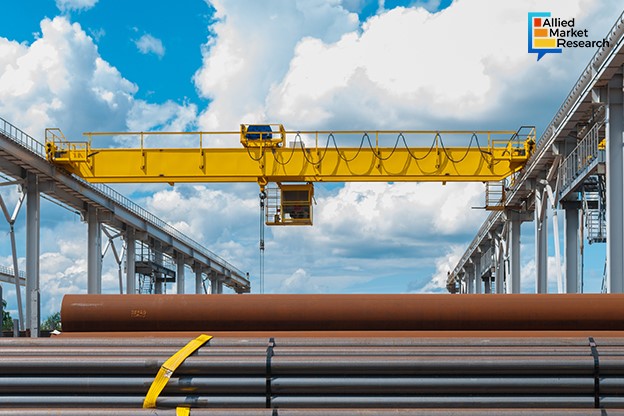Analyzing the Role of IoT and Robotics in the Expansion of the Overhead Cranes Industry

15 Jan
2025
Highlights:
- Introduction
- Integration of IoT and robotics in overhead cranes
- Innovative product launches in the sector
Overhead cranes are industrial machines that help in the lifting and transportation of heavy objects from one location to another using overhead space. Also called bridge cranes, these instruments are primarily utilized for various applications, including loading and unloading of cargo, raw material feeding, maintenance and repair works, etc. The parallel rails and the longitudinal I-beams attached to the steel columns of the crane aid in moving the load across the ceiling of an industrial facility instead of transporting it on the floor. In hazardous environments such as chemical or metal factories, this feature allows the operator to move heavy materials without putting any worker’s life at risk.
Over the years, several types of overhead cranes, including gantry, single girder, top running overhead, jib cranes, etc., have been developed by manufacturing companies to suit the demands of different end-use sectors. The efficiency and safety offered by these industrial tools make them an essential component in modern manufacturing facilities as they improve the overall operational workflow and productivity of the company.
Recent innovations in overhead cranes reshaping the different contours of the sector
The overhead cranes industry is expected to gather a sum of $7.6 billion by 2032. The market accounted for $5 billion in 2023 and is projected to rise at a CAGR of 4.8% during 2024-2032. The various technological advancements and the increasing integration of innovations are expected to play a major role in the growth of the landscape. For instance, the advent of smart cranes has helped companies enhance overall workplace safety and increase efficiency in the long run. Manufacturing enterprises have started deploying cranes that are embedded with IoT sensors for real-time monitoring and tracking of various parameters such as load weight, environmental factors, crane movement, etc.
Additionally, predictive analysis techniques are also used by these IoT-powered tools to identify various usage patterns. The data collected by these gadgets is then used to identify potential issues and problems that the machine might face in the near future. These forecasting mechanisms, thus, support proactive maintenance, reducing downtime and the cost of repair significantly. Moreover, the use of robotics solutions to automate most of the crane's functioning is another important development in the industry. The deployment of machine learning algorithms and other automation techniques to increase the accuracy and precision of overhead cranes has helped manufacturers bring down the cost of production substantially.
Furthermore, the growing awareness regarding environmental sustainability has led to the development of new crane technologies such as regenerative braking systems which help in reducing the carbon emissions caused by industrial facilities. This innovative technique involves the use of an energy recovery mechanism wherein the movement of the crane components is stopped by converting its potential or kinetic energy into electricity. The electricity, thus, produced is stored and used for future applications, thereby ultimately promoting energy efficiency. Similarly, the development of electric cranes and advanced lightweight materials have enabled crane manufacturers to effectively address the transition of various industries toward sustainability.
Konecranes and Manitowoc launch advanced overhead crane system
In the last few years, companies such as ABUS Kransysteme GmbH., Ralf Teichmann GmbH, Tri-State Overhead Crane, etc., have invested heavily in the overhead crane industry. Many other players have unveiled innovative products to gain a competitive edge over their peers in the industry. For instance, in April 2024, Manitowoc, a major crane manufacturer, announced the launch of two luffing jib cranes, viz., MR 309 and MR 329. With a maximum capacity of 16 tons and 25 tons, these cranes are powered by the Potain Crane Control System (CCS) and telematics systems for better fleet management and control.
Similarly, in August 2024, Konecranes, the world’s largest crane manufacturer, unveiled a new smart crane series, viz., Konecranes X. The new models which are part of the company’s flagship series feature CANMAN radio with an integrated display to help operators coordinate among themselves efficiently. Furthermore, TRUCONNECT Remote Monitoring technology embedded in the system aids the user in monitoring different parameters in real-time.
To summarize, the overhead cranes industry is anticipated to witness huge growth in its revenue share in the coming period due to the increasing integration of advanced technologies such as IoT and robotics. Furthermore, the high efficiency and workplace safety solutions offered by these cranes are expected to increase their applicability in different end-use industries in the near future.
Get in touch with our experts for the growth drivers and investment opportunities across the landscape!

Akhilesh Prabhugaonkar
Author's Bio- Akhilesh Prabhugaonkar holds a bachelor’s degree in Electronics Engineering from the reputed Vishwakarma Institute of Technology. He has a special interest in the fields of forensics, world history, international relations and foreign policy, sports, agriculture, astronomy, security, and oceanography. An ardent bibliophile and melophile, Akhilesh loves to write on topics of his interest and various other societal issues. This love for writing made him enter the professional world of content writing and pursue his career in this direction.
Automation in Adhesive Dispensing Equipment: Exploring the Impact of Technology Integration on the Industry
Avenue: Entire Library membership of Allied Market Research Reports at your disposal
- Avenue is an innovative subscription-based online report database.
- Avail an online access to the entire library of syndicated reports on more than 2,000 niche industries and company profiles on more than 12,000 firms across 11 domains.
- A cost-effective model tailored for entrepreneurs, investors, and students & researchers at universities.
- Request customizations, suggest new reports, and avail analyst support as per your requirements.
- Get an access to the library of reports at any time from any device and anywhere.
Related Post
-
How are Submarine Cables Transforming Global Connectivity with Enhanced User Experience?
-
Endoscopy Procedures: Transformations in Techniques and Applications
-
AI-Powered Video Analytics: How the Product Actually Works for enterprises
-
Painting Robots: Transforming Precision Coating and Creative Applications
-
Innovations in Pharmacovigilance Systems Advancing Patient Safety
-
Understanding Edge Security: Keeping Data Safe Near the Source
-
Exploring the Use and Advancements of 3D Laser Scanners in Professional Applications
-
Reinforcing Industrial Controls with Smarter Tools and Training








